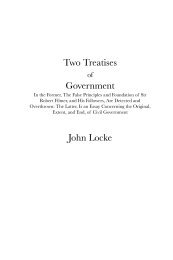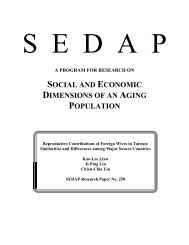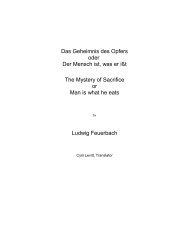AGRICULTUREmaintain completely the shepherd, his boy and a dog,not to speak <strong>of</strong> a wife and other children. Thus,while the shepherd tended his sheep, we mayimagine his wife and children were cultivating theirallotment.The wages for the harvest work <strong>of</strong> <strong>women</strong> as well asmen, were fixed by the Quarter Sessions.' Referencesto their work may be found in account books anddiaries. Thus Dame Nicholson notes : " Aug. 13,1690, I began to sher ye barin cr<strong>of</strong>t about 11 o'clock,ther was Gordi Bar and his wife-also Miler's sonJames and his sister Margit also a wife called Nietontheysher 17 threv and 7 ~hivis."~Best gives a detailed account <strong>of</strong> the division <strong>of</strong> workbetween men and <strong>women</strong> on a Yorkshire farm : " Weehave allwayes one man, or else one <strong>of</strong> the ablest <strong>of</strong> the<strong>women</strong>, to abide on the mowe, besides those that goewith the waine~.~ The best sort <strong>of</strong> men-shearershave usually 8d. a day and are to meate themselves ;the best sorte <strong>of</strong> <strong>women</strong> shearers have (most commonly)6d. a day.' It is usuall in some places (whearethe furres <strong>of</strong> the landes are deepe worne with raines)lA comparison <strong>of</strong> the assessments which have been preserved, in the di5erentcounties shows that men's earnings varied in the hay harvest from :-qd. and meat and drink, or %d. without, toSd.,, ,, ,, ,, ,, IS.4d. ,,and in the cam harvest from :-~ d and . meat and drink, or ~od. without, to1. 7, ,, ., ,, ,, 2s. 9,Women'* wages varied in the hay harvest from :-~d. and meat and drink, or qd. without, to6d. 9, 7, 1, 1 8 7,and in the corn harvest from :-zd. and meat and drink, or 6d. without, to6d.,, ,, ,, ,, ,, 18. :,The variations in these wages correspond with the price <strong>of</strong> corn in different partr<strong>of</strong> England and muct not be regarded as necessarily representing differences in thereal value <strong>of</strong> wages.%Society <strong>of</strong> Antiquarians <strong>of</strong> Scotland, vol. uxix, p. 125.Nicbolson's Account Book.a Best, Rural Emnamy, p. 36.Dame MargaretAGRICULTUREto imploy <strong>women</strong>, with wain-rakes, to gather the corneout <strong>of</strong> the said hollow furres after that the sweathrakeshave done.'. . We use meanes allwayes to getteyther 18 or else 24 pease pullers, which wee setteallways sixe on a lande, viz., a woman and a man, awoman and a man, a woman or boy and a man, etc.,the weakest couple in the fore furre. . , it is usuallin most places after they gette all pease pulled, or thelast graine downe, to invite all the worke-folkes andwives (that helped them that harvest) to supper, andthen have they puddinges, bacon, or boyled beefe,flesh or apple pyes, and then creame brought in platters,and every one a spoone ; then after all they havehotte cakes and ale ; some will cutte theire cakeand putte into the creame and this feaste is called thecreame-potte or creame-kitte . . . wee sendallwayes, the daye before wee leade, [pease] two <strong>of</strong> ourboys, or a boy and one <strong>of</strong> our mayds with each <strong>of</strong> them ashorte mowe forke to turn them."'For thatching, Best continues :" Wee usually providetwo <strong>women</strong> for helpes in this kinde, viz, one to drawethacke, and the other to serve the thatcher ; she thatdraweth thacke hath gd. a day, and shee that serveththe thatcher qd. a day, because shee also is to temperthe morter, and to carry it up to the toppe <strong>of</strong> thehowse . . . Shee that draweth thatch shouldealways have dry wheate strawe . . . whearewithto make her bandes for her bottles. She that servethwill usually carry up q bottles at a time, and sometimesbut 3 if the thatch bee longe and very ~ette."~' Be*\ Ri~ral Economy, p. jg.Ibid, pp. 93-4.Ibid, pp. 13s-g.l' The thatchers," Best says, " bare in most places 6d. a day& theire meate In Summer time, . . . yett we neaver use to give them above 4d . . .- . because their dyett is not as in other places ; for they are to have three mealeaday, vrz. theire breakfaste att eight <strong>of</strong> the clocke, . . . theire dinner about twelve andtheire supper about seaven or after when they leave worke; and att each meale.fowcr service,, viz. butter, milke, cheese, and either egges, ppes, or bacon, and sometimesporridge insteade <strong>of</strong> milke : if they meate themselves they have usua!ly ~od.a day."
62 AGRICULTURE AGRICULTURE 63" Spreaders <strong>of</strong> mucke and molehills are (for themost parte) <strong>women</strong>, boyes and girles, the bigger andabler sorte <strong>of</strong> which have usually 3d. a day, and thelesser sorte <strong>of</strong> them 2d. a day.'?' " Men that pullpease have 8d. <strong>women</strong> 6d. a day."'A picture <strong>of</strong> hay-harvesting in the West <strong>of</strong> Englandgiven by Celia Fiennes suggests that in other parts <strong>of</strong>England to which she was accustomed, the labour,especially that <strong>of</strong> <strong>women</strong>, was not quite so heavy.All over Devon and Cornwall she says, hay is carriedon the horses' backs and the people " are forced tosupport it wth their hands, so to a horse they havetwo people, and the <strong>women</strong> leads and supports them,as well as ye men and goe through thick and thinn.. . . I wondred at their Labour in this kind, forthe men and the <strong>women</strong> themselves toiled Like theirhorse^."^There was hardly any kind <strong>of</strong> agricultural work fromwhich <strong>women</strong> were excluded. Everenden " pay;:IS. 2d. to the wife <strong>of</strong> Geo. Baker for shearing 28 sheep.In Norfolk the wages for a " woman clipper <strong>of</strong> sheepe "were assessed at 6d. per day with meat and drink, IS.without, while a man clipper was paid 7d. and ~qd.It is noteworthy that only qd. per day was allowed in thesame assessment for the diet <strong>of</strong> " <strong>women</strong> and suchimpotent persons that weed corn and other such likeLaborers " and ad. per day for their wages.= Pepyson his visit to Stonehenge "gave the shepherdwoman,for leading our horses, qd.,"' while Foulisenters, " Jan. 25, 1699 to tonie to give ye <strong>women</strong> at--L Rest, Rural Economy, p. 140.a Ibid, p. 142.S Fiennes (Celia), 'Through England on a Side-saddle, p. 225.Suss. Arch. Coll. Vol. IV., p. 24.Evercndon Account Book6 Tingye U. C. ) Eng. Hist. RN, Vol. XIII., pp. 52 j-6.Pepys, Vol. V., p. 302. (11th June, 1668).restalrig for making good wailings <strong>of</strong> strae, 4s. (Scotsmoney)."'But the wives <strong>of</strong> husbandmen were not confinedto agricultural work as is shown by many paymentsentered to them in account books :' Thus the churchwardens at Strood, in Kent, paid the widow Cable forwashing the surplices IS.^ ; and at Barnsley they gave" To Ricard Hodgaris wife for whipping dogs " (out<strong>of</strong> the Church) Z S.~ while " Eustace Lowson <strong>of</strong> Salton(a carrier <strong>of</strong> lettres and a verie forward, wickedwoman in that folly) and Isabell her daughter areincluded in a Yorkshire list <strong>of</strong> recusants.=No doubt the mother with young children broughtthem with her to the harvest field, where they playedas safely through the long summer day as if they and shehad been at home. But at other times she chose workwhich did not separate her from her children, spinningbeing her unfailing resource. It is difficule living inthe age <strong>of</strong> machinery to imagine the labour whichclothing a family by hand-spinning involved,though the hand-spun thread was durable and fashionsdid not change.In spite <strong>of</strong> the large demand the price paidwas very low, but when not obliged to spin for sale,Foulis (Sir John) Acct. Bk., p. 246."Aug. 7th. I701 to my wife, to a Bleicher wife at bonaley for blcitching1. 3. 4." (Scots)" Jan. 28th, 1703 to my good douchter jennie to give tibbie tomsome for herattendance 011 my wife the time <strong>of</strong> her sickness 5.16.0 (Scots). (Foulis (SirJohn) Acc~. Bk. p. 295, 314.)" Sep. I xth, 1676, pd. her (Mary Taylor) more for bakeing four days. MothersAcct. 8d. ( Fell, (Sarab) Housebold Accts. p. 309.)" Pd. Widow Lewis for gathering herbs two daies 6d. ( Sussex, Arch. Coll. xlviii.p. 120. Extracts from the Household Account Book <strong>of</strong> Herstmonccux Castle.)Paid to goodwife Stopinge for 2 bundles <strong>of</strong> Rushes at Whitsuntide for theChurch, iiijd. (Cburcbwarden's Account Book, Strood, p. 95, 1612.Churcbwarden's Account Book, Strood, p. 197. 1666.COX Q. C.) Churcbwarden's Accts., p. 309.Tmks. North Riding, Q. S. Rec., Vol. I,, p. 62, Jan. 8. 1606-7.
- Page 1 and 2: WORKING LIFE OF WOMENIN THESEVENTEE
- Page 3 and 4: PREFACEboth can be studied in the w
- Page 5 and 6: 2 INTRODUCTORY INTRODUCTORY 3is det
- Page 7 and 8: INTRODUCTORYThese circumstances hav
- Page 9 and 10: 10 INTRODUCTORY INTRODUCTORYthis pe
- Page 11 and 12: CAPITALISTSTerm includes aristocrac
- Page 13 and 14: CAPITALISTSA granddaughter of Olive
- Page 15 and 16: CAPITALISTSsuch as noe way entangle
- Page 17 and 18: 26 CAPITALISTS CAPITALISTS 27Wellin
- Page 19 and 20: 30 CAPITALISTS CAPITALISTS 3'years
- Page 21 and 22: CAPITALISTSboth, so that there coul
- Page 23 and 24: 38 CAPITALISTShis Lady was taking d
- Page 25 and 26: AGRICULTURE 43AGRICULTUREAgricultur
- Page 27 and 28: AGRICULTURE AGRICULTURE 47two Weeks
- Page 29 and 30: AGRICULTUREFitzherbert's descriptio
- Page 31 and 32: 54 AGRICULTUREamong the gentry. The
- Page 33: 5 8 AGRICULTURE AGRICULTURE 59was u
- Page 37 and 38: AGRICULTUREthe same work,' a marrie
- Page 39 and 40: AGRICULTUREThe Justices in the Nort
- Page 41 and 42: AGRICULTUREIn some places the labou
- Page 43 and 44: AGRICULTURELabourers naturally were
- Page 45 and 46: 82 AGRICULTURE AGRICULTUREdenyed a
- Page 47 and 48: AGRICULTUREpayne of xs a weeke and
- Page 49 and 50: AGRICULTUREThe conduct of the magis
- Page 51 and 52: 94 TEXTILES TEXTILESIt requires som
- Page 53 and 54: TEXTILESchildren were said to be em
- Page 55 and 56: TEXTILES TEXTILES 103respect obtain
- Page 57 and 58: TEXTILES TEXTILES'07people who had
- Page 59 and 60: I 10 TEXTILES TEXTILES I111693 to p
- Page 61 and 62: I 14 TEXTILES TEXTILES 115books,' b
- Page 63 and 64: 118 TEXTILES TEXTILES 119money in p
- Page 65 and 66: 122 TEXTILES TEXTILES 123clothing w
- Page 67 and 68: 126 TEXTILES TEXTILESclosely imitat
- Page 69 and 70: 1 30TEXTILESspinsters' maximum wage
- Page 71 and 72: TEXTILESa mownte in the yere t o jM
- Page 73 and 74: '38 TEXTILES TEXTILESD. Silk, and G
- Page 75 and 76: 142TEXTILES TEXTILES '43end. And it
- Page 77 and 78: TEXTILESbranches of the woollen ind
- Page 79 and 80: CRAFTS AND TRADESCHAPTER V.--CRAFTS
- Page 81 and 82: CRAFTS AND TRADES CRAFTS AND TRADES
- Page 83 and 84: I 58CRAFTS AND TRADESwith the wife
- Page 85 and 86:
CRAFTS AND TRADES CRAFTS AND TRADES
- Page 87 and 88:
CRAFTS AND TRADES. . . . shall teac
- Page 89 and 90:
I 70 CRAFTS AND TRADES CRAFTS AND T
- Page 91 and 92:
CRAFTS AND TRADESone month the Mast
- Page 93 and 94:
178 CRAFTS AND TRADES CRAFTS AND TR
- Page 95 and 96:
182 CRAFTS AND TRADES CRAFTS AND TR
- Page 98 and 99:
I 88 CRAFTS AND TRADES CRAFTS AND T
- Page 100 and 101:
192 CRAFTS AND TRADESIn the unprote
- Page 102 and 103:
CRAFTS AND TRADESand eleven sisters
- Page 104 and 105:
200 CRAFTS AND TRADES CRAFTS AND TR
- Page 106 and 107:
CRAFTS AND TRADES CRAFTS AND TRADES
- Page 108 and 109:
CRAFTS AND TRADESBut if a woman be
- Page 110:
2 12 CRAFTS AND TRADES CRAFTS AND T
- Page 114 and 115:
CRAFTS AND TRADES CRAFTS AND TRADES
- Page 116 and 117:
CRAFTS AND TRADESalso defended as a
- Page 120 and 121:
CRAFTS AND TRADESfrom her fellow pa
- Page 122 and 123:
PROFESSIONS 237PROFESSIONSIntroduct
- Page 124 and 125:
24O PROFESSIONS PROFESSIONStheir Th
- Page 126 and 127:
244 PROFESSIONS PROFESSIONS 245the
- Page 128 and 129:
PROFESSIONS PROFESSIONS 249profanat
- Page 130 and 131:
252PROFESSIONSGiles Moore enters in
- Page 132 and 133:
PROFESSIONScribed as one who " dist
- Page 134 and 135:
PROFESSIONS PROFESSIONS 261first ma
- Page 136 and 137:
264 PROFESSIONSGarrett's leg shall
- Page 138 and 139:
268 PROFESSIONSwhere there are none
- Page 140 and 141:
PROFESSIONS PROFESSIONS 273the numb
- Page 142 and 143:
PROFESSIONSexaminations, before six
- Page 144 and 145:
PROFESSIONS PROFESSIONS 281death me
- Page 146 and 147:
284 PROFESSIONS PROFESSIONSof confi
- Page 148 and 149:
288 PROFESSIONSextent they were whe
- Page 150 and 151:
CONCLUSIONor in her other facilitie
- Page 152 and 153:
CONCLUSION CONCLUSION 297in women's
- Page 154 and 155:
CONCLUSIONlaw of Nature, inviolable
- Page 156 and 157:
CONCLUSIONwere specially deprecated
- Page 158 and 159:
308 CONCLUSIONof the State, and the
- Page 160 and 161:
312 AUTHORITIES AUTHORITIES 313Cost
- Page 162 and 163:
AUTHORITIESMartindale, Adam, The Li
- Page 164 and 165:
County.Buckingham ..Cardigan .. ..C
- Page 166 and 167:
INDEXINDEXFlax, 64, 146, 246, 291 ;
- Page 168:
INDEXsmants, women( 50,65,157 ; mam








